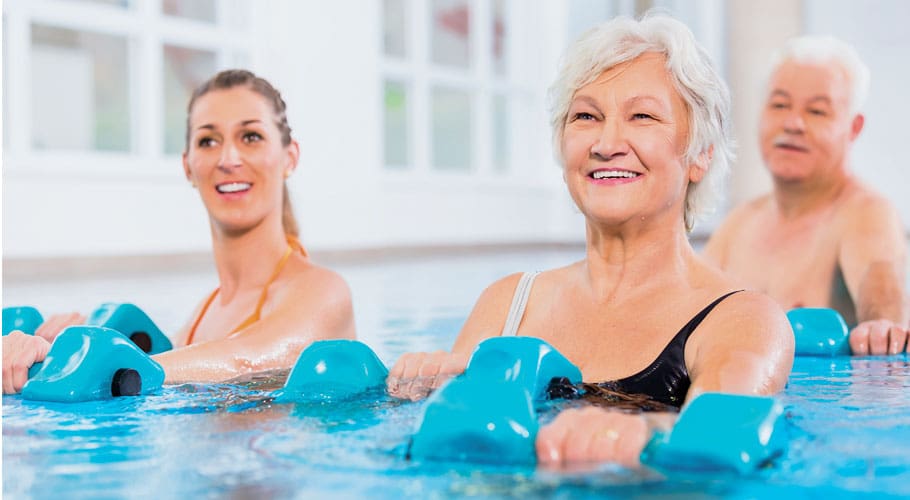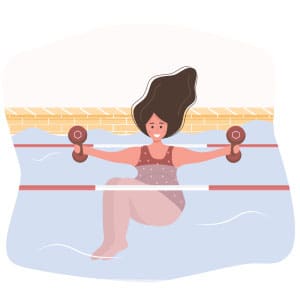For Your Health

Water workouts offer the ability to increase muscle in a low-impact environment.
© NEW AFRICA / Stock.adobe.com
Wade a while
Aquatic movement can help with pain or mobility issues, and as an alternate form of exercise
by JACKIE DUDA
Humans are roughly 60% water, so it makes sense that exercising in water, in the form of aquatic therapy, could play a part in your health.
“Arthritis and spinal cord injury patients benefit from aquatic therapy,” says Dr. Bruce Becker, founding director of the National Aquatic and Sports Medicine Institute at Washington State University and a retired physiatrist—a doctor who specializes in physical medicine and rehabilitation after disabling conditions such as stroke and spinal cord injuries. Becker, a Costco member, says aquatic exercise offers unique benefits for people of all ages and abilities, with studies showing cardiovascular, circulatory, respiratory and endocrine benefits, and improved muscle strength, walking, balance, memory and mood.
Gain strength, reduce pain
“[Aquatic therapy is] a good option for gaining strength, because buoyancy makes it easier to exercise in the water,” says Costco member Dr. Albert Recio, a physician in the paralysis restoration program at the International Center for Spinal Cord Injury at the Kennedy Krieger Institute. Buoyancy supports them, and hydrostatic pressure, the force of water against the body, helps circulation. “Hydrostatic pressure promotes muscle relaxation and helps decrease swelling,” explains Recio.
Being in the water also decreases pain. Judy Peck, a physical therapist, has worked with patients for 24 years, witnessing the pain-relieving effects. “Our goal is to teach patients what to do to decrease pain, improve flexibility and strength, and help them mentally when they’re struggling with chronic pain,” she explains. Patients are often surprised by the mental and physical relief: “Many feel relief even hours later,” says Peck.
Recovering from injury
Costco member Michael Murray, president of the American Physical Therapy Association Academy of Aquatic Physical Therapy, sees a wide spectrum of patients, from injured athletes to people for whom aquatic therapy was a last resort.
Murray and his colleagues at Duke studied healthy people walking in shallow water, demonstrating how buoyancy lessened impact on lower extremities and resistance increased strength and some joint mobility. “If you have a condition that’s degenerative, aquatic therapy helps strengthen you to live more independently on land,” says Murray. He notes that high-intensity aquatic exercises can help maintain bone density, but osteoporosis patients also need to include weight-bearing exercises on land, as a combination of aquatic and land therapy can help them to get stronger and functionally independent.
Meeting special lifestyle needs
Recio works with patients of all ages with mild to severe neurological, rehabilitative or developmental needs. He published groundbreaking research on how aquatic therapy improved activities of daily living, such as personal care and hygiene, for patients with tracheostomies, colostomies and pressure injuries. “We’re trying to demonstrate we can eliminate barriers for patients with complex medical conditions. We have developed policies and procedures allowing patients with ventilators and diaphragmatic pacers in the pool for skilled therapies,” Recio explains, adding that these patients hadn’t previously been considered for aquatic exercise. “Aquatic therapy gives them more independence.”
“Everything you do from the standpoint of exercise, in water or on land, has health benefits,” Becker emphasizes. “The body is very smart. It’s always looking for ways to recover. The water facilitates that.”
Aquatic exercises
Exercises vary, depending on whether one is pre- or post-operative, trying to lose weight, recovering from injury, strengthening weak muscles or trying to live better with chronic pain.
Many start with walking, marching and squats in waist-deep water.
Exercises in chest-deep water might include aqua dumbbells, noodles and kickboards for resistance, or adding ankle weights to augment the strengthening effects of water walking and leg lifts. For safety, wear an aqua belt or life vest.—JD

© Kzenon / Stock.adobe.com
Wading in
Knowing how to swim isn’t necessary for aquatic therapy; therapists accompany patients in the water. Some insurance companies require a doctor’s prescription. All patients should discuss any new exercise program with their doctors first.
You can find aquatic therapy programs on the American Physical Therapy Association websites (apta.org; aquaticpt.org); or online (search “aquatic therapy near me”).
At the YMCA of Frederick County in Frederick, Maryland, for example, participants can sign up for classes like Aqua Yoga, Thera-Walk or Splashin’ to the Oldies, says Samm Meddaugh, the Y’s aquatics director. Another option is to reserve time to swim or walk in the pool lanes.—JD
Jackie Duda swims three times a week and engaged in aquatic therapy to recover from a life-threatening medical crisis.
Costco Connection: Swimsuits, goggles, fins and other water-related items can be found seasonally in Costco warehouses and year-round at Costco.com.



